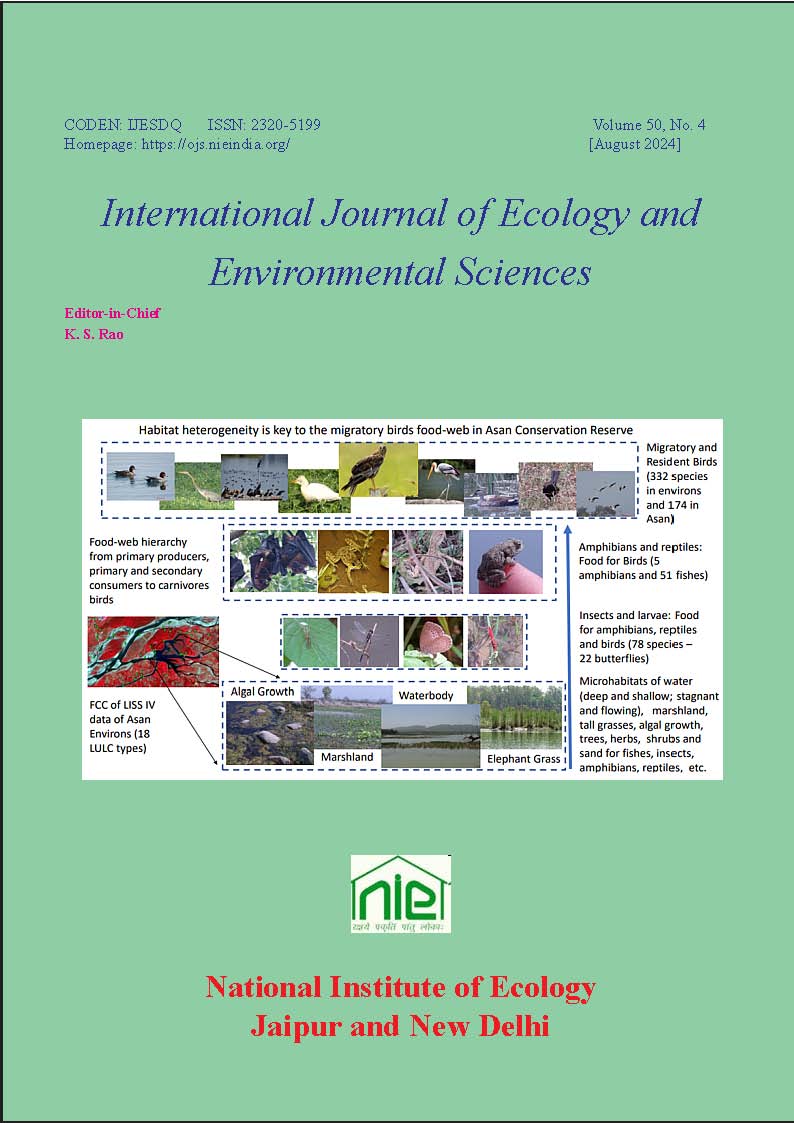Exploring the Influence of Biophilic Workplace Design on Employee Creativity: A Comparative Study
DOI:
https://doi.org/10.55863/ijees.2024.0166Keywords:
Employee creativity, Biophilia, Nature-inspired Design, Sustainable Designs, Built Environment, Creative Working SpaceAbstract
This research delves into the influence of office spaces infused with biophilic elements on the creativity of employees, examining differences across various biophilic indices. The study follows a correlational and comparative research design and data were collected from 222 employees including 152 workers from organisations with low biophilic index and 70 workers from organisations with high biophilic index following purposive sampling method. Biophilia Index has shown a significant positive correlation and a strong predictive value for creativity of employees and considerably higher correlation is found in environment factor of creativity. The t-test results indicate that employee creativity and its dimensions are comparatively higher in the group with high biophilic index than the group with low biophilic index. These findings emphasize the significance of integrating nature-inspired design features in workplaces to augment creativity, particularly focusing on the environmental facets of the work place setting.
References
Alayis, M.M., Amin, A.Z. and 2020. The effect of indoor environment quality on customer service employees' creativity in telecommunication companies in Saudi Arabia. International Journal of Innovation, Creativity and Change, 13(4), 1203-1222. https://doi.org/10.1080/23311886.2023.2223398
Aldabbas, H., Pinnington, A. and Lahrech, A. 2023. The influence of perceived organizational support on employee creativity: The mediating role of work engagement. Current Psychology, 42(8), 6501-6515. https://doi.org/10.1007/s12144-021-01992-1
Amabile, T.M., Conti, R., Coon, H., Lazenby, J. and Herron, M. 1996. Assessing the work environment for creativity. Academy of Management Journal, 39(5), 1154-1184. https://doi.org/10.5465/256995
Barjak, F. and Heimsch, F. 2023. Understanding the relationship between organizational culture and inbound open innovation. European Journal of Innovation Management, 26(3), 773-797. https://doi.org/10.1108/EJIM-03-2021-0139
Caple, D. 2019. Creativity in design of green workplaces. pp. 92-96. In: Bagnara, S., Tartaglia, R., Albolino, S., Alexander, T. and Fujita, Y. (Eds) Proceedings of the 20th Congress of the International Ergonomics Association (IEA 2018) Volume VII: Ergonomics in Design, Design for All, Activity Theories for Work Analysis and Design, Affective Design 20. Springer, Cham. https://doi.org/10.1007/978-3-319-96071-5_10
Chulvi, V., Agost, M.J., Felip, F. and Gual, J. 2020. Natural elements in the designer's work environment influence the creativity of their results. Journal of Building Engineering, 28, 101033. https://doi.org/10.1016/j.jobe.2019.101033
De Vries, S., van Dillen, S.M.E., Groenewegen, P.P. and Spreeuwenberg, P. 2013. Streetscape greenery and health: Stress, social cohesion and physical activity as mediators. Social Science & Medicine, 94, 26-33. https://doi.org/10.1016/j.socscimed.2013.06.030
Dobson, J., Birch, J., Brindley, P., Henneberry, J., McEwan, K., Mears, M., Richardson, M. and Jorgensen, A. 2021. The magic of the mundane: The vulnerable web of connections between urban nature and wellbeing. Cities, 108, 102989. https://doi.org/10.1016/j.cities.2020.102989
Emami, M., Rezaei, S., Valaei, N. and Gardener, J. 2023. Creativity mindset as the organizational capability: the role of creativity-relevant processes, domain-relevant skills and intrinsic task motivation. Asia-Pacific Journal of Business Administration, 15(1), 139-160. https://doi.org/10.1108/APJBA-12-2020-0437
Fromm, E. 1964. The Heart of Man. Harper and Row Publishers, Evanston and London. 128 pages.
Hes, D. and du Plessis, C. 2014. Designing for Hope: Pathways to Regenerative Sustainability. Routledge, London. 252 pages. https://doi.org/10.4324/9781315755373
Kaplan, S. 1995. The restorative benefits of nature: Toward an integrative framework. Journal of Environmental Psychology, 15, 169-182. https://doi.org/10.1016/0272-4944(95)90001-2
Martin, L., White, M.P., Hunt, A., Richardson, M., Pahl, S. and Burt, J. 2020. Nature contact, nature connectedness and associations with health, wellbeing and pro-environmental behaviours. Journal of Environmental Psychology, 68, 101389. https://doi.org/10.1016/j.jenvp.2020.101389
McCoy, J.M. and Evans, G.W. 2002. The potential role of the physical environment in fostering creativity. Creativity Research Journal, 14(3-4), 409-426. https://doi.org/10.1207/S15326934CRJ1434_11
Palanica, A., Lyons, A., Cooper, M., Lee, A. and Fossat, Y. 2019. A comparison of nature and urban environments on creative thinking across different levels of reality. Journal of Environmental Psychology, 63, 44-51. https://doi.org/10.1016/j.jenvp.2019.04.006
Plambech, T. and Konijnendijk, C.C. 2015. The impact of nature on creativity – A study among Danish creative professionals. Urban Forestry & Urban Greening, 14(2), 255-263. https://doi.org/10.1016/j.ufug.2015.02.006
Sailer, K. 2011. Creativity as social and spatial process. Facilities, 29(1/2), 6-18. https://doi.org/10.1108/02632771111101296
Salingaros, N.A. 2006. A Theory of Architecture. Sustasis Press, Portland, OR.
Sen, S., Acar, S. and Cetinkaya, C. 2014. Development of the Person–Environment Fit Scale (PEFSC): A new measure of creativity. Psychology of Aesthetics, Creativity, and the Arts, 8(4), 433-445. https://doi.org/10.1037/a0037724
Suckley, L. and Nicholson, J. 2018. Enhancing creativity through workspace design. Pp. 245-263. In: Martin, L. and Wilson, N. (Eds.) The Palgrave Handbook of Creativity at Work. Palgrave Macmillan, Cham. https://doi.org/10.1007/978-3-319-77350-6_12
Suresh, S., Kumar, N. and Singh, D.K. 2023. Unveiling the restorative power of employees in the context of biophilic built environment: A well-being perspective. International Journal of Ecology and Environmental Sciences, 49(6), 645-649. https://doi.org/10.55863/ijees.2023.3052
Ulrich, R.S. 1993. Biophilia, biophobia, and natural landscapes. Pp. 73-137. In: Kellert S.R. and Wilson E.O. (Eds.) The Biophilia Hypothesis. Island Press, Washington, DC.
Wilson, E.O. 1986. Biophilia. Harvard University Press, Cambridge, MA.
Yin, J., Arfaei, N., MacNaughton, P., Catalano, P.J., Allen, J.G. and Spengler, J.D. 2019. Effects of biophilic interventions in office on stress reaction and cognitive function: A randomized crossover study in virtual reality. Indoor Air, 29(6), 1028-1039. https://doi.org/10.1111/ina.12593
Zhou, J. and Hoever, I.J. 2014. Research on workplace creativity: A review and redirection. Annual Review of Organizational Psychology and Organizational Behavior, 1(1), 333-359. https://doi.org/10.1146/annurev-orgpsych-031413-091226
Downloads
Published
How to Cite
Issue
Section
License
Copyright (c) 2023 Sandra Suresh, Dharmendra Kumar Singh, Narsingh Kumar

This work is licensed under a Creative Commons Attribution-NonCommercial 4.0 International License.


